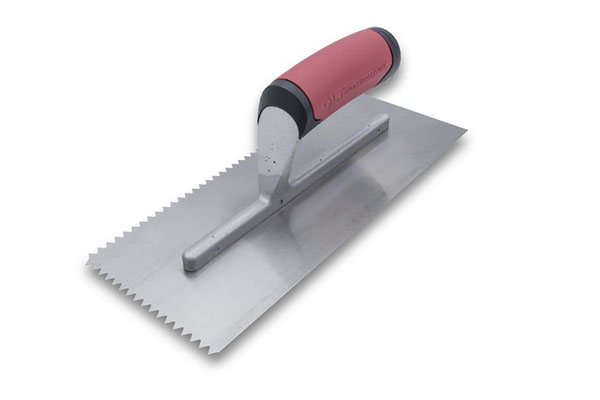जब यो टाइलिंग र फर्श परियोजनाहरु को लागी आउँदछ, सही उपकरणहरु एक चिकनी, व्यावसायिक समाप्त र एक गन्दा परिणाम बीच सबै भिन्नता बनाउन सक्छ। टाँसेको समान रूपमा फैलाउनको लागि सबैभन्दा आवश्यक उपकरणहरू मध्ये एक हो खाच भएको ट्रोवेल, र यसको भिन्नताहरू बीच, V खाच ट्रोवेल विशिष्ट अनुप्रयोगहरूको लागि बाहिर खडा छ। तर वास्तवमा V notch trowel को लागि प्रयोग गरिन्छ, र किन यो केहि परियोजनाहरूमा रुचाइएको छ? यसको उद्देश्य, फाइदाहरू र उत्कृष्ट अभ्यासहरू अन्वेषण गरौं।
V Notch Trowel के हो?
एक V notch trowel एउटा ह्यान्डल भएको फ्ल्याट धातु वा प्लास्टिकको औजार हो, जसमा दाँतहरू एक वा दुवै किनाराहरू छन् जुन अक्षर "V" जस्तो आकारको हुन्छ। खाचहरू समान रूपमा दूरीमा राखिन्छन् र ब्लेडमा काटिन्छन्, सतहमा टाँसिएको वा मोर्टार फैलिएको बेला रिजहरू सिर्जना गर्दछ। यी रिजहरूले समान वितरण सुनिश्चित गर्दछ, टाइलहरू वा अन्य सामग्रीहरू सुरक्षित रूपमा बाँड्न मद्दत गर्दछ।
खाचको आकार फरक हुन सक्छ — सामान्यतया ३/१६”, १/४”, वा ठूला — प्रयोग भइरहेको टाइल र टाँसेको प्रकारमा निर्भर गर्दछ। साना नचहरूले कम टाँसिने सुविधा दिन्छ, जबकि ठूला नोचहरूले बाक्लो तह लागू गर्छन्।

V Notch Trowel को प्राथमिक प्रयोगहरू
-
साना टाइलहरू र मोजाइकहरू स्थापना गर्दै
V notch trowels को लागि प्राय: प्रयोग गरिन्छ सानो ढाँचा टाइलहरू जस्तै मोज़ाइक, सबवे टाइलहरू, र 6 इन्च मुनि टाइलहरू। यी टाइलहरूलाई टाँस्ने बाक्लो तहको आवश्यकता पर्दैन, र V-आकारको रिजहरूले ग्राउट लाइनहरू बीचमा झर्ने अतिरिक्त सिर्जना नगरी मात्र पर्याप्त बन्डिङ सामग्री प्रदान गर्दछ। -
ब्याकस्प्लासका लागि टाँस्ने पदार्थ लागू गर्दै
भित्ता स्थापनाहरू जस्तै किचन वा बाथरूम ब्याकस्प्लासहरूका लागि, V नोच ट्रोवेलहरू उपयुक्त छन्। तिनीहरूले पातलो, तहहरूमा पनि टाँस्ने टाईलहरू फैलाउँछन्, यो सुनिश्चित गर्दै कि हल्का तौलका टाइलहरू ठाडो सतहहरूमा चिप्लिएनन्। -
विनाइल वा कार्पेट टाइलहरू सेट गर्दै
सिरेमिक र पोर्सिलेन टाइलहरू बाहेक, V नोच ट्रोवेलहरू पनि टाँस्ने सामग्रीहरू लागू गर्न प्रयोग गरिन्छ। विनाइल टाइलहरू, कार्पेट टाइलहरू, र अन्य लचिलो फर्श। यी सामग्रीहरूलाई सामान्यतया गोंदको पातलो आवेदन चाहिन्छ, जुन V notch trowel प्रभावकारी रूपमा उद्धार गर्दछ। -
पातलो बेड अनुप्रयोगहरू
कुनै पनि परियोजना को आवश्यकता छ पातलो ओछ्यान टाँस्ने विधि V notch trowel बाट फाइदा। उपकरणले टाँस्ने तह पातलो तर सुसंगत छ, गाँठहरू रोक्न र बलियो आसंजन सुनिश्चित गर्दछ।
स्क्वायर नोचको सट्टा V Notch Trowel किन प्रयोग गर्ने?
-
कम टाँसेको वितरण: V आकारले स्क्वायर वा U नोच ट्रोवेलहरू भन्दा कम टाँसेको जम्मा गर्दछ, जुन साना टाइलहरूका लागि उपयोगी छ जसलाई बाक्लो ओछ्यान चाहिँदैन।
-
राम्रो चिपकने कवरेज: V notch द्वारा सिर्जना गरिएका तीखो चट्टानहरू समान रूपमा पतन हुन्छन् जब टाइलहरू थिचिन्छन्, शून्यहरू बिना पूर्ण कभरेज सिर्जना गर्दछ।
-
क्लिनर फिनिस: धेरै टाँस्ने पदार्थ प्रयोग गर्दा यसलाई टाईलहरूको बीचमा निचोर्न सक्छ, ग्राउटिंग गन्दा बनाउँछ। V notch trowels ले यस समस्यालाई कम गर्न मद्दत गर्दछ।
यसको विपरित, वर्ग वा U खाच trowels ठूला-ढाँचा टाइलहरू, प्राकृतिक ढुङ्गाहरू, वा बाक्लो टाँस्ने तह चाहिने अनुप्रयोगहरूको लागि राम्रोसँग उपयुक्त छन्।
सही साइज V नच ट्रोवेल छनोट गर्दै
V notch को सही आकार तपाईंको परियोजनामा निर्भर गर्दछ:
-
३/१६” V नच: मोज़ाइक, सानो सिरेमिक टाइल्स, वा हल्का भित्ता टाइलहरूको लागि उत्तम।
-
1/4” V खाच: थोरै ठूला टाइलहरू (4-6 इन्च) वा बाक्लो विनाइल टाइलहरूको लागि उपयुक्त।
-
अनुकूलन सिफारिसहरू: सँधै टाँस्ने निर्माताको दिशानिर्देशहरू जाँच गर्नुहोस्, किनकि केहीले उचित कभरेजको लागि आवश्यक खाच आकार निर्दिष्ट गर्न सक्छ।
V Notch Trowel प्रभावकारी रूपमा प्रयोग गर्नका लागि सुझावहरू
-
ए मा ट्रोवेल समात्नुहोस् ४५-डिग्री कोण एकसमान रिजहरू सिर्जना गर्न टाँसिएको फैलाउँदा।
-
टाईलहरू सेट हुनु अघि टाँसिएको सुकाउनबाट रोक्नको लागि सानो खण्डहरूमा काम गर्नुहोस्।
-
रिजहरू भत्काउन र कभरेज प्राप्त गर्नको लागि टाईलहरूलाई दृढतापूर्वक ठाउँमा थिच्नुहोस्।
-
नचिङलाई असर गर्ने बिल्डअपलाई रोक्न प्रयोगको क्रममा नियमित रूपमा ट्रोवेल सफा गर्नुहोस्।
निष्कर्ष
A V खाच ट्रोवेल पातलो, टाँस्ने तहहरू पनि आवश्यक पर्ने परियोजनाहरूका लागि एक अनिवार्य उपकरण हो। यो मुख्य रूपमा साना टाइलहरू, मोजाइकहरू, ब्याकस्प्लासहरू, र विनाइल वा कार्पेट टाइलहरू जस्तै लचिलो फर्शहरू स्थापना गर्न प्रयोग गरिन्छ। V-आकारको रिजहरूले थप गडबड बिना बलियो बन्धन सुनिश्चित गर्दै, लागू गरिएको टाँसिएको मात्रालाई नियन्त्रण गर्दछ।
छोटकरीमा, यदि तपाइँ सानो-ढाँचाको टाइलहरू वा हल्का तौल सामग्रीहरूसँग काम गर्दै हुनुहुन्छ भने, V notch trowel व्यावसायिक फिनिश प्राप्त गर्नको लागि उत्तम विकल्प हो। ठूला टाइलहरू वा भारी-कर्तव्य अनुप्रयोगहरूका लागि, तथापि, आवश्यक टाँस्ने मोटाई डेलिभर गर्नको लागि तपाईंलाई स्क्वायर वा यू नोच ट्रोवेल चाहिन्छ।
पोस्ट समय: सेप्टेम्बर-11-2025






